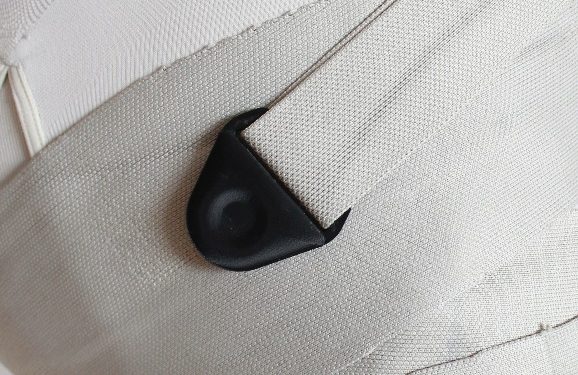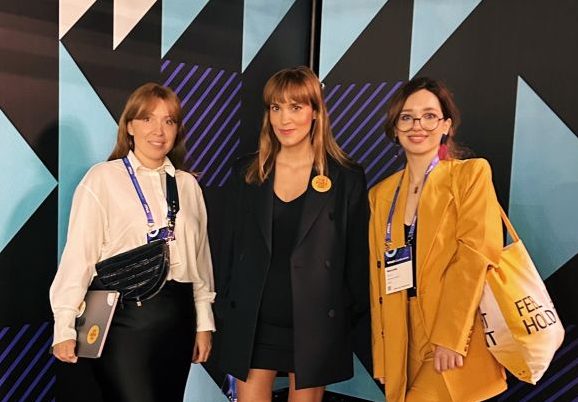3D Printing on Textiles
3D printing technology is gaining popularity across various industries, offering new opportunities for design and production. One of the latest and most innovative applications of this technology is direct printing onto fabric. Raised 3D prints on textiles are a fashionable and eye-catching addition to any outfit, creating the impression that the print extends beyond the garment's surface. At the same time, it can be a novel and functional solution. This was precisely the case for producing straps for a maternity suit. The project was initiated by HUGUP, a pioneer in advanced medical products. Their offerings address both health and aesthetic needs, providing patients with a sense of safety and comfort.
The Idea and Initiative by HUGUP Startup
HUGUP is setting new standards in medical care. Their goal is to produce medical equipment that not only meets health requirements but also enhances patients’ comfort and quality of life. The HUGUP team identified issues related to pregnancy and proposed a specialized suit for women to alleviate joint pressure, distribute body weight, and transfer it to the shoulders using special straps.

Seeking innovative solutions, HUGUP approached Omni3D, an industrial 3D printing leader, with a project to manufacture and attach fasteners to nylon maternity straps. This article presents the details of this pioneering initiative, its benefits, and potential impact on the maternity wear market.
3D Printing by Omni3D
The production of the straps and suits takes place at a sewing workshop in Italy, while the realization of the fasteners designed by The TAKŁADNIE Design Cooperative in the form of 3D prints directly onto the straps is carried out by Omni3D, based in Poznań. The industrial 3D printer manufacturer used its Omni TECH 3D printers to develop an innovative process for producing the fasteners.

Omni3D faced the challenge of 3D printing on fabric, which needed to meet dimensional, quality, and durability requirements. The 3D printing specialists adapted the model for fabric printing, selected suitable filaments, and optimized settings and parameters to ensure the print adhered well to the material. This created a 3D printing process that allowed for precise adjustment of the fasteners’ shape and the straps’ properties to the specific project requirements.
“No other company, apart from Omni3D, offered such comprehensive support for this specific low-volume production. They helped us adapt files for 3D printing, selected the filaments, and proposed a solution. Using 3D printing opened the door to faster and more tailored approaches to our needs. It was especially valuable because we weren’t sure what would work best, and many conceptual changes were still taking place.” – said Kamila Przybylska, Project Manager at HUGUP.
Properties of the Applied Filament
A carbon-fiber-reinforced polyamide-based filament was used for printing the fasteners. This material features high mechanical strength, abrasion resistance, and temperature resistance, making it ideal for producing components exposed to significant stress and challenging operating conditions.
Benefits of Using 3D Printing
The use of 3D printing technology has brought numerous benefits:
- Customization: The ability to adjust the shape and color of the fasteners to individual needs (different strap sizes). Freedom in modifications and versioning.
- Production Speed: Reduced time from design to finished product, enabling rapid changes.
- High Quality: The carbon-fiber-reinforced polyamide material ensures the durability and strength of the fasteners, while the Omni TECH printer guarantees dimensional accuracy, surface quality, and print consistency.
- Cost Efficiency: 3D printing enabled low-volume production without incurring high costs associated with tools and molds. It proved to be the most cost-effective option.
Potential Impact on the Market
The HUGUP project in collaboration with Omni3D has the potential to revolutionize the medical apparel market. The innovative suits can significantly improve comfort and support for pregnant women, which is crucial for their health and well-being. Additionally, the use of 3D printing could open new opportunities for clothing manufacturers, allowing them to respond more quickly to market needs and introduce innovative products.

Summary
The partnership between HUGUP and Omni3D is an example of an innovative approach to design and production. Thanks to advanced 3D printing technology, it is possible to create products that are user-tailored, durable, and cost-effectively manufactured. This solution opens new possibilities for clothing manufacturers to quickly respond to market demands and introduce new, innovative products.
HUGUP has started product testing at the Mother and Child Institute, where this unique solution for pregnant women has a chance to demonstrate its effectiveness in practice. We wish them the best of luck and are excited to be part of this project.

